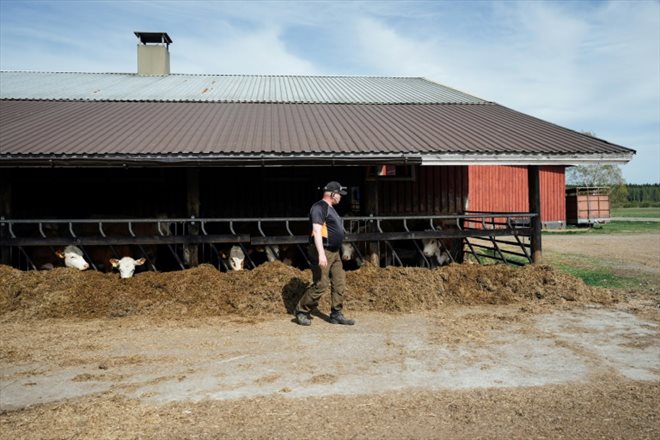A flock of wild geese flies over a field in Parikkala, Finland, on May 16, 2023 (AFP/Alessandro RAMPAZZO)
In a cacophony of cries that sound like a hailstorm, tens of thousands of hungry wild geese cover a green field in Finland with their black paws.
“There are probably around 20 to 30 hectares behind me, which are easily devoured in a day,” Kari Pekonen, a farmer in Parikkala in South Karelia, told AFP.
In this eastern region that is home to boreal forests and wetlands, global warming is pitting farmers against an adversary with an endearing name: the barnacle goose.
Twenty years ago, few wild geese stopped in Finland to feed on their long migration to the Arctic from their wintering grounds in the Netherlands and Germany. Today, they number in the hundreds of thousands.

The effect of a group of wild geese passing over a field in Parikkala, Finland, on May 16, 2023 (AFP/Alessandro RAMPAZZO)
As a result, farmers and geese are in fierce competition for arable land.
In this season, the grass should reach the shins, but instead, there are only strands left, laments Mr. Pekonen. The palmipeds fed heavily on the 250 hectares of meadows supposed to feed the cows.
The amount of damage amounts to about two-thirds of his income, according to the farmer.
Third generation of his family to raise beef cattle, Kari Pekonen had to part with a large part of his herd: the herd went from 300 head to less than 100 in two years.
– Drones, lasers, speakers –
To protect their crops without harming the birds, farmers have tried to put in place solutions to scare them away, each one more creative than the other.

Farmer Kari Pekonen shows a tool he made himself in an attempt to scare away geese from his fields on his farm in Parikkala, Finland, on May 16, 2023 (AFP/Alessandro RAMPAZZO)
Solar-powered laser cannons, drones resembling birds of prey… Loudspeakers have even been installed, spitting out the cries of panicked geese… The results are mixed.
This species gets used “quickly to the fact that we try to hunt it”, explains Mika Pirinen, government official specializing in compensation. “The same measure therefore does not work from one year to the next”.
Like many migratory birds, the barnacle goose, a medium-sized waterfowl with black and white plumage, is vulnerable to climatic disturbances.
Every spring, the geese leave their wintering grounds in continental Europe to lay eggs in the tundra of the Arctic archipelagos of Novaya Zemlya in Russia and Svalbard in Norway.

A flock of wild geese flies over a field in Parikkala, Finland, on May 16, 2023 (AFP/Alessandro RAMPAZZO)
On the way to their nesting grounds, before attacking the last stage over the Arctic Ocean, they stop to refuel, opting for the point on the continent closest to their final destination.
When the springs of northern Europe were still cold, these halts took place further south.
But with warming, “the stopping places of barnacle geese have changed dramatically,” says Teemu Lehtiniemi, research director at BirdLife, a conservation organization.
As a result, “the best place to prepare for the last leg of the journey is further and further north”, notes Mr. Lehtiniemi.
– “Impossible task” –
Threatened with extinction in the 1970s largely due to hunting, the number of geese had dropped to 10,000. International protection agreements have allowed their population to soar.

Farmer Kari Pekonen walks past a barn on his farm in Parikkala, Finland, on May 16, 2023 (AFP/Alessandro RAMPAZZO)
Kari Pekonen, like several of his fellow farmers, would like to be able to resume waterfowl hunting.
For BirdLife’s Teemu Lehtiniemi, this could indeed scare the geese, but this solution is not viable.
“There will always be geese, there will be lots of them, and they will need a place to feed,” he notes.
At what price?, retorts Mr. Pekonen.
“In the spring, (to scare them) is an impossible task, because you also have to deal with agriculture”.
As the species is protected, the state must pay compensation for any damage caused to agriculture, amounting to more than 3 million euros per year in eastern Finland alone, so the Institute of Resources Naturelles de Finland plans to designate certain fields as exclusively reserved for geese.
Not enough to convince farmers. Many have already thrown in the towel, says Kari Pekonen.
“Everyone must ask themselves if they are ready to work for a third of their salary. Why would we do it?” he complains.
“Let’s see when people are hungry, what lesson they will learn from it”.
© 2023 AFP
Did you like this article ? Share it with your friends with the buttons below.




